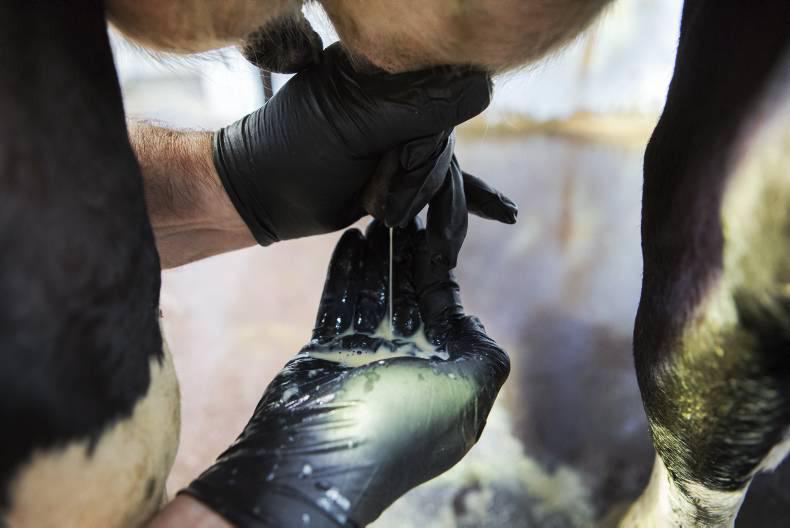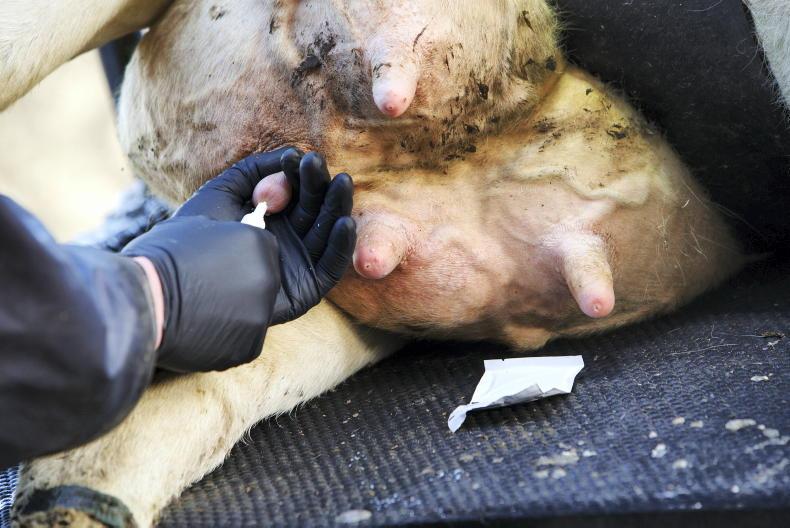In 2004, the average somatic cell count (SCC) in Ireland was 255,000. Last year, the average SCC in milk-recorded herds was 175,000, with figures for the national herd expected to be similar when they are released later in the year.
High SCC milk is bad as it indicates mastitis in the herd. This costs the farmer in terms of increased treatment costs and lower milk yield from high SCC cows. High SCC milk is harder to process with fewer and lower-value dairy products manufactured from high SCC milk.
With this in mind, CellCheck was formed in 2010 as part of Animal Health Ireland to coordinate the national mastitis programme with the remit to improve the SCC of Irish milk. The industry-agreed goal of CellCheck is to have 75% of the milk produced in Ireland with an SCC of 200,000 or less by 2020. Finola McCoy is the programme coordinator.
Since then, SCC on Irish farms has been declining steadily, with 55% of Irish milk with an SCC of less than 200,000 last year. The graph above details the average SCC from milk-recorded herds since 2010. The availability of national data from processors has only become available in more recent years but, according to Finola, it closely matches milk recorded averages.
Workshops
At this stage, over 2,000 dairy farmers have participated in CellCheck workshops, mostly through discussion groups and co-op groups. As part of the new Knowledge Transfer programme, participants in this scheme will be required to attend a CellCheck workshop, unless they have attended a workshop in the last 18 months, in which case they are deemed exempt.
The workshops take place on a farm and are attended by the group facilitator, local vet, milk quality person from the co-op and a milking machine technician.
According to Finola, the average SCC on a farm falls by between 40,000 and 50,000 after a farmer participates in a CellCheck workshop and this is over and above the fall in SCC that is occurring nationally.
“Attending the workshop is an opportunity for self-reflection by the farmer. It makes him or her more aware of poor milking practices and outlines the areas where improvements in SCC can be made. Having all the professionals together in the one workshop really drives home the messages because we know that solving SCC problems involves a number of approaches.” Finola says.
According to Finola, the cost of participating in a CellCheck workshop is about €40 per person, which with the support of Skillnet covers the cost of the workshop.
So if SCC levels are declining nationally, are we seeing fewer cases of clinical mastitis? Finola says there is preliminary research to show that sales of lactating mastitis tubes are declining and that sales of dry cow tubes are static. “Considering that the national herd is increasing in size, this is positive but whether it is as a result of reduced incidences of mastitis or because of more prudent use of antibiotics, we can’t be sure.”
One thing Finola says she can see coming down the track is increased regulation around dry cow therapy, which will require a more targeted approach based on the individual SCC of the cow, rather than blanket treatment of all cows.
Problem areas
Finola says that the one area where farmers can make big gains in the battle against SCC is in the use of teat sprays. She says that on most farms where there is an SCC problem, there is ineffective or inadequate use of teat sprays.
“It’s mostly down to technique and time. Most farmers are using teat sprays but are they using them effectively? They only work well if the whole teat is covered, so this means that at least 15ml of teat spray should be used per cow per milking. To cover all of the teat surface area, you must move the teat spray nozzle and spend sufficient time spraying each cow,” Finola says.
Milk recording
Finola is a big advocate for milk recording, saying that farmers who don’t milk-record regularly are limiting their ability to solve an SCC problem because they don’t have accurate information on the SCC of individual cows in a herd.
“Currently, about one third of the herds in Ireland are being milk re-corded, but about 50% of the cows are milk recorded because it tends to be carried out on the larger herds.
‘‘If we are to reach our goal of 75% of the milk produced being under an SCC of 200,000, then milk recording needs to increase in Ireland.”
One area that is a cause of concern for Finola and her team is the fact that now that quotas are gone, farmers may become less selective with what cows they are going to milk and milk cows that should really be culled in the desire to produce more milk. But this has not been observed to date, with milk recorded figures still showing a decline in SCC in 2015.
CellCheck awards
Since 2013, CellCheck has rewarded farmers with outstanding SCC by awarding them with a plaque in recognition of the excellent SCC levels on their farm. Each year, the 500 farmers with the lowest SCC in the country for the previous year are awarded the prize. Last year, the range in SCC for the winning farmers was between 37,000 and 97,000 SCC.
SCC is declining in Ireland. Last year, the average SCC in milk-recorded herds was 175,000.Just over 50% of the milk produced in Ireland has an SCC of less than 200,000.CellCheck coordinates the CellCheck workshop which farmers participating in the Knowledge Transfer scheme are required to attend.Poor technique at teat spraying is a cause of most of the problems with SCC on many farms.
In 2004, the average somatic cell count (SCC) in Ireland was 255,000. Last year, the average SCC in milk-recorded herds was 175,000, with figures for the national herd expected to be similar when they are released later in the year.
High SCC milk is bad as it indicates mastitis in the herd. This costs the farmer in terms of increased treatment costs and lower milk yield from high SCC cows. High SCC milk is harder to process with fewer and lower-value dairy products manufactured from high SCC milk.
With this in mind, CellCheck was formed in 2010 as part of Animal Health Ireland to coordinate the national mastitis programme with the remit to improve the SCC of Irish milk. The industry-agreed goal of CellCheck is to have 75% of the milk produced in Ireland with an SCC of 200,000 or less by 2020. Finola McCoy is the programme coordinator.
Since then, SCC on Irish farms has been declining steadily, with 55% of Irish milk with an SCC of less than 200,000 last year. The graph above details the average SCC from milk-recorded herds since 2010. The availability of national data from processors has only become available in more recent years but, according to Finola, it closely matches milk recorded averages.
Workshops
At this stage, over 2,000 dairy farmers have participated in CellCheck workshops, mostly through discussion groups and co-op groups. As part of the new Knowledge Transfer programme, participants in this scheme will be required to attend a CellCheck workshop, unless they have attended a workshop in the last 18 months, in which case they are deemed exempt.
The workshops take place on a farm and are attended by the group facilitator, local vet, milk quality person from the co-op and a milking machine technician.
According to Finola, the average SCC on a farm falls by between 40,000 and 50,000 after a farmer participates in a CellCheck workshop and this is over and above the fall in SCC that is occurring nationally.
“Attending the workshop is an opportunity for self-reflection by the farmer. It makes him or her more aware of poor milking practices and outlines the areas where improvements in SCC can be made. Having all the professionals together in the one workshop really drives home the messages because we know that solving SCC problems involves a number of approaches.” Finola says.
According to Finola, the cost of participating in a CellCheck workshop is about €40 per person, which with the support of Skillnet covers the cost of the workshop.
So if SCC levels are declining nationally, are we seeing fewer cases of clinical mastitis? Finola says there is preliminary research to show that sales of lactating mastitis tubes are declining and that sales of dry cow tubes are static. “Considering that the national herd is increasing in size, this is positive but whether it is as a result of reduced incidences of mastitis or because of more prudent use of antibiotics, we can’t be sure.”
One thing Finola says she can see coming down the track is increased regulation around dry cow therapy, which will require a more targeted approach based on the individual SCC of the cow, rather than blanket treatment of all cows.
Problem areas
Finola says that the one area where farmers can make big gains in the battle against SCC is in the use of teat sprays. She says that on most farms where there is an SCC problem, there is ineffective or inadequate use of teat sprays.
“It’s mostly down to technique and time. Most farmers are using teat sprays but are they using them effectively? They only work well if the whole teat is covered, so this means that at least 15ml of teat spray should be used per cow per milking. To cover all of the teat surface area, you must move the teat spray nozzle and spend sufficient time spraying each cow,” Finola says.
Milk recording
Finola is a big advocate for milk recording, saying that farmers who don’t milk-record regularly are limiting their ability to solve an SCC problem because they don’t have accurate information on the SCC of individual cows in a herd.
“Currently, about one third of the herds in Ireland are being milk re-corded, but about 50% of the cows are milk recorded because it tends to be carried out on the larger herds.
‘‘If we are to reach our goal of 75% of the milk produced being under an SCC of 200,000, then milk recording needs to increase in Ireland.”
One area that is a cause of concern for Finola and her team is the fact that now that quotas are gone, farmers may become less selective with what cows they are going to milk and milk cows that should really be culled in the desire to produce more milk. But this has not been observed to date, with milk recorded figures still showing a decline in SCC in 2015.
CellCheck awards
Since 2013, CellCheck has rewarded farmers with outstanding SCC by awarding them with a plaque in recognition of the excellent SCC levels on their farm. Each year, the 500 farmers with the lowest SCC in the country for the previous year are awarded the prize. Last year, the range in SCC for the winning farmers was between 37,000 and 97,000 SCC.
SCC is declining in Ireland. Last year, the average SCC in milk-recorded herds was 175,000.Just over 50% of the milk produced in Ireland has an SCC of less than 200,000.CellCheck coordinates the CellCheck workshop which farmers participating in the Knowledge Transfer scheme are required to attend.Poor technique at teat spraying is a cause of most of the problems with SCC on many farms. 











SHARING OPTIONS